¿Podrá Jurassic World Alive hacer frente a Pokémon Go?
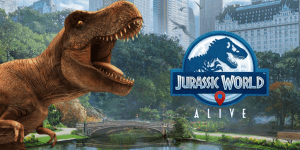
El mercado de los juegos basados en la ubicación se está calentando este verano. Finalmente estamos comenzando a ver que algunos desarrolladores importantes presentan una respuesta a Pokémon Go de Niantic, un juego que ya tiene casi 2 años y es más fuerte que nunca. Pokémon Go es un elemento básico en las listas de mayores ingresos y, dado que el número de usuarios alcanzó un máximo histórico este mes , es probable que continúe. Por ello, hay muchos que intentan repetir su éxito. Niantic planea otro título este verano, “Harry Potter: Wizards Unite”. NEXT Games ha lanzado su “Walking Dead: Our World”. Ludia + Universal acaba de lanzar “Jurassic World Alive” junto con el lanzamiento de la nueva película.
Consulta nuestra Biblia de diseño de juegos gratuitos aquí

Este verano se lanzarán tres juegos basados en la ubicación. ¿Puede alguno repetir el éxito de Pokémon Go?
Pero muchos en el sector móvil cuestionaron cuán repetible es el éxito de Pokémon Go. La mayoría diría que su éxito se basa en gran medida en la marca Pokémon. Entonces, ¿qué posibilidades tienen otros juegos basados en la ubicación?
Juegos basados en la ubicación: la nueva frontera para la retención
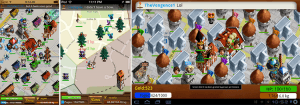
Los juegos basados en la ubicación existen desde 2008. Juegos como Parallel Kingdoms de Per Blue
Los juegos basados en la ubicación son públicos desde hace algún tiempo. Desde que los teléfonos inteligentes tenían GPS, los desarrolladores de juegos han utilizado la ubicación en sus juegos. Parallel Kingdom, un juego de Per Blue allá por 2008 fue uno de los pioneros de este género. Ingress de Niantic en 2012 es una iteración obvia de este género. Ninguno de estos juegos funcionó notablemente bien. Entonces, si todos esos juegos fracasaron y Pokémon Go tuvo éxito, ¿fue sólo la licencia o fue algo más? ¿Qué cambió en 2016?

El modo AR es más un obstáculo que un elemento clave del juego. La mayoría de los jugadores desactivan esto.
Algunos han señalado el auge de la Realidad Aumentada como una de las razones del éxito de Pokémon Go, pero esto no es realmente cierto. Si bien Pokémon Go tiene componentes de Realidad Aumentada, su novedad desaparece rápidamente. Muchos jugadores informan que desactivan el modo AR bastante rápido después de jugar. La verdadera AR (que utiliza el reconocimiento visual para superponer elementos virtuales al mundo real) no es un componente importante de Pokémon Go. Simplemente permite a los jugadores jugar en el modo de captura usando su cámara. El modo AR en realidad hace que el juego de captura sea más difícil e inconveniente. La RA se utilizó para marketing más que como mecanismo de retención . Entonces, ¿qué es lo que realmente impulsa la asombrosa curva de retención de Pokémon Go? (Visto a continuación)
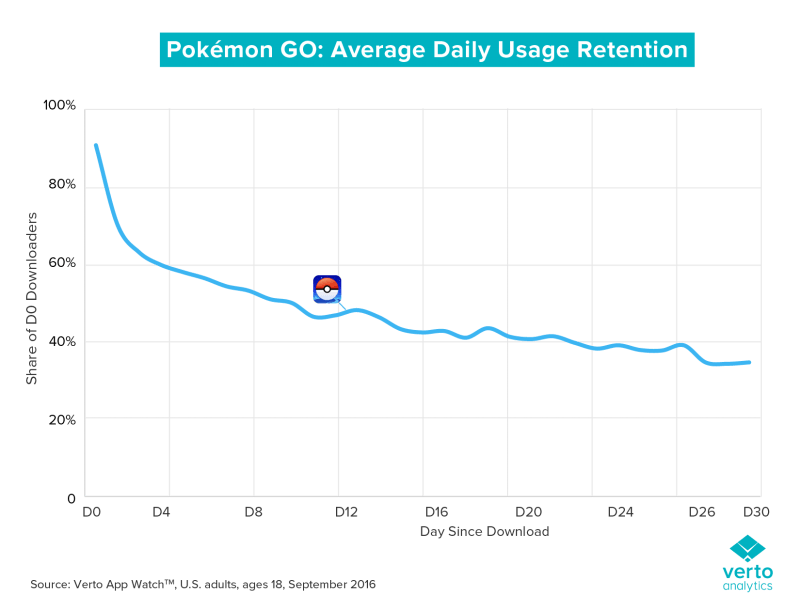
My hypothesis is that the success of Pokemon Go was partly based on branding, partly based on virality, but mostly because of the retention differences when using location as a trigger for gameplay.
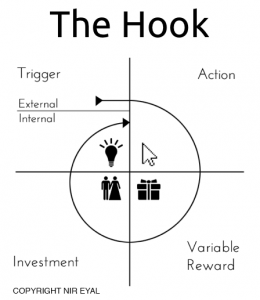
What I mean by trigger here comes from psychology. Taken from “Hooked” a book by Nir Eyal, we have a framework for what drives retention in apps and games.
To drive players to come back often:
- a player sees a visual trigger to enter the game (a player is bored, sees the icon on their phone)
- which has short, effective sessions (playing a quick match 3 level)
- with variable rewards (sometimes I win, sometimes I lose)
- that build long-term investment (reaching level 1000+ on a saga map)
All successful games use this loop to drive long-term retention. What changes in location-based gaming is the Trigger — the first step — pulling players into the game.
In typical mobile games, the trigger can be external (a push notification telling you your energy has refilled) or internal (I’m bored, let’s see if I can beat this level now). A location-based game has a new type of trigger — walking around in the world, being in a new place. Players that are stuck to games like Pokemon Go will tell you their trigger points — every time they’re getting a coffee, they check for Pokemon. Every time they are out at a restaurant, they check for pokemon. On their commute to work, they’re checking for pokemon.
If a game can attach itself to a commonly felt stimuli and use it as a trigger to play a game — this is an effective retention driver.
So location-based games, when they’re working, will build psychological triggers to play the game when you’re commuting, driving more repeat sessions and higher long-term retention. But do players have an appetite for multiples of these games?
Can a game with a lesser brand compete in this category? (sorry Jurassic Park, I love you but Pokemon is bigger)

Pokemon (Blue) vs Jurassic Park (Red) in Google Trends in the last 12 months. Even with the recent movie, Pokemon is a bigger brand.
Deconstructing Jurassic World Alive
Enter Ludia, a company that has proven over the last years to be confident in entering new genres and succeeding. Founded in 2007, they’ve focused on Facebook and mobile licensed games. They were acquired by Freemantle media in 2010, and have seen continued success since then. Associating with big brands, they’ve gone on to build consistent successes on mobile. Recently, they’ve built up the Jurassic Park games on mobile. Leveraging the brand and combining with the Dragonvale framework, they’ve carved out a success on mobile within a genre (Dragon Breeding) which has been out of the spotlight for years.

Their approach to taking the Jurassic Park brand and associating it with location-based gaming looks based upon Pokemon Go, but clearly trying to fix the aspects that were missing from the experience. Where Pokemon Go is a collector’s game, Jurassic Park is a competitive battle game.
The Core Loop
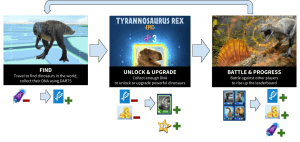
The core loop of Jurassic World Alive is simple yet effective. It builds upon the working framework of Pokemon Go, and adds a key element: battling.
- Find dinosaurs on your map, and send a drone to collect DNA from it. Based on how well you play the mini-game, the more DNA you collect.
- This DNA is converted into dinosaurs in a Clash Royale style system. The more DNA you collect, the faster you can unlock a dino and upgrade it.
- Using your upgraded dinos, you can battle other players, which rewards players with chests. These chests contain everything you need to restart the loop: coins and darts.
The keys here are the currency sources sinks:
- Finding dinos takes darts, which can only be collected from battling and a daily free chest. So you need to battle to collect and upgrade.
- Coins are needed to upgrade, unlock, and fuse dinosaurs. Coins start off plentiful but become tighter and more strategic as you reach the end game.
- XP is gained only from unlock upgrading. So levelling up is relative to how big high levelled your collection is. Collecting upgrading any dinosaur is helpful.
- Upgrading your dinosaurs is needed to keep battling. As you battle, your elo rating is improving, forcing you to match against more and more difficult players. In order to keep up with the matchmaking, you need to be constantly upgrading your dinosaurs.
Let’s go into each step in more detail:
Collecting Dinosaurs
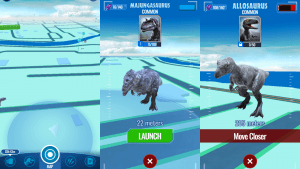
The game’s main screen is the map. It takes a perspective view of a typical google map and shows you the locations of dinosaurs currently wandering your city. If you’re close enough to a dinosaur, you can send a drone out to collect DNA from it. If you’re not, you’re going to have to move closer.
For this mechanic, Ludia creates an upsell mechanic. The radius of being able to capture a dinosaur is pretty small for free players, but if you pay into their VIP system, you get an increased radius for collecting. A compelling reason for beginning + lazy players (like myself) to commit to playing the game. Very smart!
Besides this, Jurassic World Alive conveniently places a few dinosaurs near you every session. So even as a lazy player that mostly checks their devices in similar to locations, you can still make good progress. A must for location-based games.
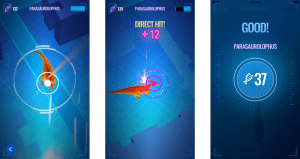
If you’re in radius, you can send a drone to pick up DNA from the dinosaur. This is a pretty compelling minigame of aiming with your drone and sending darts to collect DNA. A bit of timing, prediction and control wonkiness make it a pretty exciting minigame. Direct hits can get you large amounts of DNA, so being more accurate pays off big time.
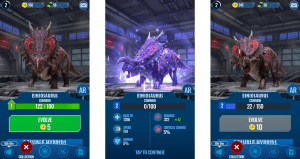
DNA is a precious resource, it’s similar to cards in Clash Royale. The more DNA you collect, the faster you can unlock and evolve a monster. Giving a very compelling reason to play well in the mini-game. This makes their progression significantly more skill-based than most, makes it more difficult to balance for different play types, but makes the DNA collecting minigame much more compelling. As you progress and start wanting to collect rarer and rarer dinos, you only have limited chances to collect the DNA, adding further pressure to be on the lookout for the best dinosaurs.
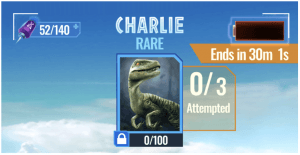
Long Term Retention: Fusion System
One interesting addition Ludia have added to the Pokemon Go/Clash Royale style system is the addition of Fusion:
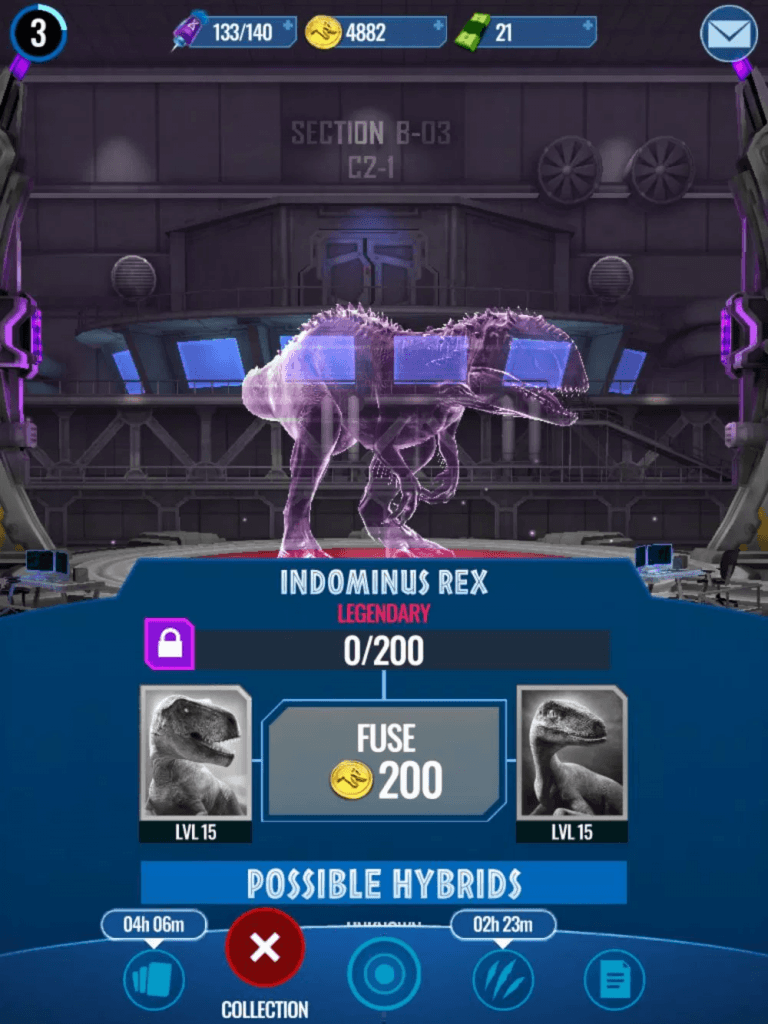
The fusion system allows players to create specific hybrids of dinosaurs. There are a number of pre-designed recipes which require you to combine two dinos (ex. Combining t-rex and raptor to create indominus, just like the movie). This typically requires both to be a high enough level as well as a modest fusion cost. This is how you can create legendary level dinosaurs.
It’s a smart tie in from the movie that adds significant depth to their chase for the best dinosaurs.
In the case of Clash Royale, it can get frustrating with some of those early cards not being of use in the endgame. Also having no visual change to a character after unlocking it feels less powerful. With the fusion system, having a goal to level up a set of characters to unlock a more powerful character is a good long term retention system.
So overall, Jurassic World Alive has a nice mix between Clash Royale and Pokemon Go, with some interesting additions. Being able to influence how much DNA/Duplicates you collect is great for players (less so for balancers), and adding the fusion system creates a visible long term goal.
The Battle
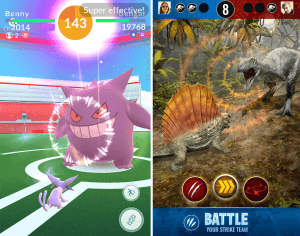
JW:Alive significantly builds upon Pokemon Go’s simplistic battle system.
Comparing Jurassic World Alive’s battle system to Pokemon Go’s, you can clearly see that Ludia took the weakest system from Niantic and improved on it substantially.
Pokemon Go opted for a system that is centered around their experience — location-based design. Instead of making battles central to their core loop, battles can only be done at certain locations (gyms), making battling tied to an overall social goal (take gyms for your team), and make it very asynchronous (the winner leaves a defending team for attackers to try to beat). The actual battle mechanic itself is really simplistic — bring 6 of your best pokemon in, and just tap madly on the screen to try to damage them as much as possible. There’s some skill in dodging and in selecting pokemon, but Pokemon Go’s battle system isvery shallow that’s gotten plenty of criticism from their fanbase.
The Challenge of a 1v1 Battle
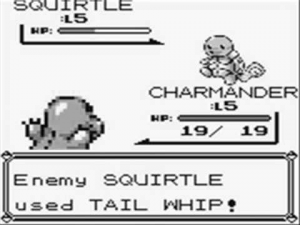
To be honest, Pokemon’s original battle mechanic wasn’t that great either. Since it was single player experience, the original Pokemon games were balanced very much in favour of the player. So they could get away with the game being pretty simplistic. When players started battling pokemon in PvP, there wasn’t alot of depth. The strategy usually was to keep swapping pokemon until you had the advantage on the field. Because it was a 1 on 1 turn-based battle, it didn’t leave a lot of room for countering and strategy. It’s why most turn-based PvP RPG games today typically have more fighters on the field (ex. 3v3 in Summoner’s War) or add a grid to move around units to create interesting countering tactics (ex. Fire Emblem Heroes).
Jurassic World Alive seems to have taken the original Pokemon style battling system and built it out so that it actually can function as a 1v1 PvP RPG battle with a healthy meta. Instead of dinosaurs having clear explicit strengths and weaknesses (ex. Water dinosaurs and weak against flying dinosaurs?) they’ve gone for a system where dinosaurs have much less obvious strengths and weaknesses. There’s no explicit rock-paper-scissors strategy, and it makes for a better game.
There are many types of dinosaurs, some with high health, some with quick attacks, some with high damage, some with status effects, and some as a hybrid. The strategy becomes trying to use your dinosaurs to the best of their abilities: having your high health dinos suck up damage, high attack dinos rip through without taking damage, and having your speedy dinos to do the final blow, preventing the opponent from attacking back. Overall, I counted 19 different attack types. This creates a nice base layer of strategy for a 1v1 game.
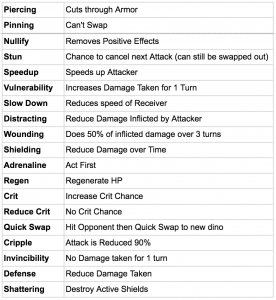
With status effects this also means that a dino’s strengths and weaknesses can change through a battle. Remember “Tail whip” from Pokemon? A useless move to increase damage taken by your opponent? — here in Jurassic World Alive it actually makes strategic sense. These moves have enough impact to make you second guess leaving your dinos in a weakened state.

Take out 3 dinos before your opponent does
The goal of the battle is to take down 3 opposing dinosaurs before your opponent does. You bring in 4 dinosaurs, and can switch as often as you’d like. Similar to pokemon however, swapping out your dino leaves them susceptible to a free attack by the opponent.
So typically what happens is there’s some mind reading of your opponent. You make assumptions when they will swap out their dinos and try to take advantage of them losing a move.
Overall this gives the PvP battles a good level strategy. You’re trying to counter the opponent’s, while preventing swapping at the wrong time. You’re trying to avoid your opponent from saving their speedier dinos, who can take down your weaker dinos without being hit back. The upgrades and matchmaking also keep battles intense — most battles feel like you lost because of skill.
However, some of the battle’s elements show that they can’t break away from the innate issues of a Pokemon style battle: a core strategy of the game is to try to guess what your opponent will switch to. Guess that your opponent will start with a heavy armor dino? Then start with an armor piercing one. Guess that your opponent will swap a weak dino before you can kill it? Then make them pay by using your special attack rather than your weaker one. This is fun to pull off, but call-your-bluff/mind-reading strategy isn’t going to last for the long term.
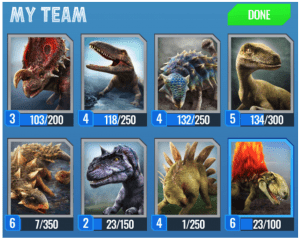
On top of this, your battle team is made up of 8 dinos, yet when you battle, it randomly selects 4 out of the 8. This feels like a tacked-on system to increase the pressure to upgrade more dinosaurs rather than increasing the strategy before the battle. As a player it means you have some arbitrary randomness about whether the strategy you wanted to use will pay off, and can mean that right from the onset of the battle you already feel like you’ve lost (you got a bad draw from move 1). While randomness can be good, this much pre-determined luck can make players feel helpless early in battle.
This points to an issue that the 1v1 gameplay has. It’s just too limiting. The in-game strategy hits a cap which turns into a mind-reading battle, and the out-of-game strategy is limited so they had to tack on a “random 4” system.
I wonder if the game’s battle system would have been better if they’d broken from the pokemon style design and instead gone with something like a 3v3 battle system. Increasing complexity, but increasing the depth substantially. There would be substantially more attack types, more in-game strategy. Makes swapping dinos a far more interesting choice, and makes directly countering a more nuanced strategy.
Regardless, the Jurassic World Alive battle system is far better than the tap fest that is Pokemon Go — I just wonder if it could have been even stronger with a 3v3 system.
Pacing Progression
And just for good measure, to pace the battle system, Jurassic World Alive relies on the good ol’ chest system from Clash Royale. Instead of pacing you based on energy, players can only have 4 chests at a time, and each chest must be opened one at a time. Because of matchmaking and the importance of stats in the outcome of a battle, it prevents players from rushing too far ahead by winning too many battles. Eventually, you will need what’s in the chests in order to compete.
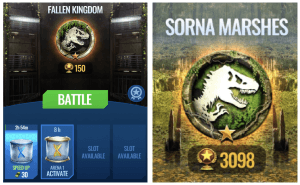
From Clash Royale: Chest Slots and Arena Tiers
Arena tiers are another borrowed feature from Clash Royale. Players earn trophies for victories, which unlock higher and higher tiers which contain bigger prizes and better dino DNA each time you win. This gives a clear, compelling reason to keep playing.
Comparing to Pokemon Go, my goal in the game is far more explicit and I can make progress towards it immediately: reach the next arena.
3 Reasons why it’s Working

Regardless of your thoughts of Jurassic Park IP or Location-based gaming,Jurassic World Alive is within the Top 100 grossing, and has sustained there since launch. While I think many would dismiss this as a “lesser Pokemon Go” — it clearly has done something right.
I believe that there are 3 key reasons why Jurassic World Alive has seen success so far:
#1 – Smart Merchandising
Merchandising — the features of a game that are typically there to upsell players towards spending money — are top notch in Jurassic World Alive. Ludia consistently have launched games that have taken the best merchandising practices and executed on them well. In Jurassic World Alive this really is showcased in their VIP System:

Jurassic World Alive showcases throughout the game the value of their VIP system. From the onset, you are constantly shown that a dinosaur is just out of reach on your map — the cure? Join VIP! This is an excellent conversion leverage point. On top of this, getting an epic incubator and increased supply drops makes the progression far easier.
The VIP system is also a subscription. Utilizing the latest trends in F2P, which is now even a common tactic in Hyper Casual games. The power of committing players to an ongoing subscription seems to be driving a lot of revenue these days (hopefully not too much off the back of forgetful users…).
#2 – Clear Progression Goals
As mentioned above, one aspect I think Jurassic World Alive does far better than Pokemon Go is the visibility and clarity of their progression system and goal systems.
For Pokemon Go, the goal is mostly focused on completing your Pokedex. This is alright for collectors, but it doesn’t hit all player types. Jurassic World includes the Battle loop + arenas, which give a clear focus for battling your dinosaurs. Now there’s a way to clearly show off my progress and a competition I can engage in that will give me clear progress clear recognition.
Comparing this to Pokemon Go, having to go to Gyms, and choosing a team which is far too large to feel impactful within makes the competitive goals far too end-game heavy. In the beginning, the goal is just to collect — and this is only compelling for so long.
#3 – Less Reliant on Location-Based Gameplay
Lastly, I think it was a smart choice for Jurassic World Alive to make their systems less dependant on the location-based gameplay. In Jurassic World Alive you can have many sessions without ever really caring about the map or moving to different locations.
Within Jurassic World Alive, usually there are a number of dinosaurs directly near me that helps me progress. These “freebies” may not be the optimal path, but still help me progress faster and give a reason to check my phone even when I’ve been in the same location for awhile (which, if you’re like lazy me, is common).
On top of this, the battle system chest system not being location specific means that throughout the day when I’m not walking around I can still complete a meaningful session. I can open up chests, start the opening of the remaining. I can win some battles and fill up my slots. I can open up my free incubator.
Comparing to Pokemon Go, it instead relies a lot on location-based design. Incubators require you to remember to walk around with them on (which is a pain). Gyms are at specific locations, making you need to remember to check your phone at that location to make meaningful progress. While this is great for getting some location-based retention, it can make “regular” mobile sessions a pain in Pokemon Go.
Jurassic World Alive, on the other hand, is stronger because it has location-based elements, but you can still play the game often without needing to worry about where you are.
But can it hold up?
Looking at the grossing charts now, it looks like it will stabilize within the Top 150 grossing. While the movie is still in theatres and advertisements are running daily, they should be able to sustain here.
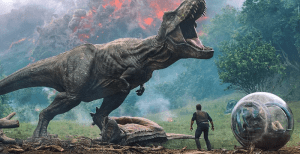
Lo que se pronostica sin embargo es que caerá, y será complicado retenerlo dentro del Top 250 . Este aumento de los espectadores y de la propiedad intelectual es inevitable, pero mantenerse a este nivel seguirá siendo difícil. Esto se debe en parte a que la marca (no es Marvel) no hay una película nueva cada 6 meses. No es Harry Potter; la base de fans no es tan grande. La naturaleza simple de la propiedad intelectual será la resistencia de Jurassic World Alive.
Desde el punto de vista del diseño también hay algunos problemas:
La batalla es efectiva, pero aún así demasiado simple. Construir un meta duradero debería ser una prioridad. Impulsar a los jugadores a recolectar y mejorar una gama más amplia de dinosaurios es crucial, y el sistema actual de elegir aleatoriamente 4 de 8 no es lo suficientemente fuerte. Podrían impulsar este ancho desde algunos juegos PvE, cambiando el meta de manera más explícita en los eventos, o cambiando el PvP a 3v3. Cualquiera de las dos puede ser una forma de impulsar a los jugadores a recolectar y mejorar una gama más amplia de dinosaurios para competir.
Falta el componente social. Mientras que Pokémon Go ha ido acumulando esto con el tiempo, Alive todavía tiene formas de funcionar y lanzarse con menos funciones que Pokémon en el lanzamiento. Sin señuelos, sin chat, sin clanes. Por ahora, esto está bien, pero para aprovechar el juego basado en la ubicación e impulsar a los jugadores locales a trabajar juntos como lo hace Pokémon Go, agregar algunas formas para que los jugadores se comuniquen y creen estrategias localmente sería una adición simple pero excelente.
Ludia es una excelente empresa que ha demostrado una y otra vez que puede ingresar a nuevas categorías con confianza y cumplir con las operaciones en vivo. Este juego no debería ser diferente. No tengo ninguna duda de que Ludia podrá aprovechar la sólida base de este juego, responder a los comentarios de los jugadores, extender el juego de batalla para que dure más, diseñar eventos que hagan retroceder a los jugadores y desarrollar funciones sociales que se desarrollarán con el tiempo.
Espero que esto sea un elemento básico en la lista de mayores ingresos, pero no uno que supere a Pokémon Go. Sin embargo, no creo que eso sea necesario para tener éxito aquí; lo que todos deberíamos sacar de esto es que los juegos basados en la ubicación pueden ser más interesantes de lo que todos pensábamos.
El verano de 2016 fue el verano de la gacha de Clash Royale .
2017 fue el verano del juego Battle Royale.
2018 puede ser el verano de los juegos basados en la ubicación.
Leave a Reply